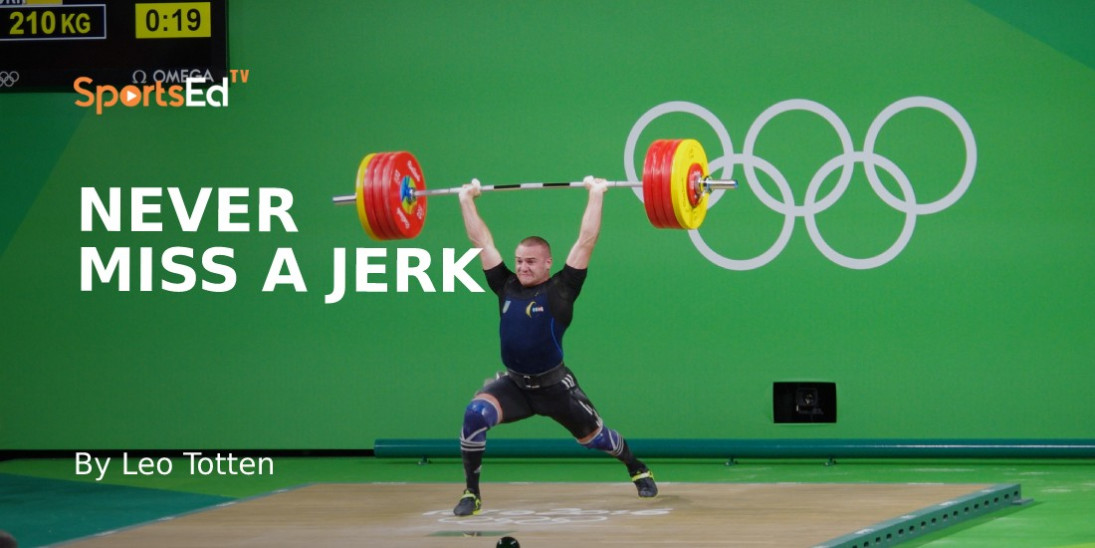Weightlifting
Welcome and thanks for visiting...

Never Miss a Jerk Again!

Coach Totten offers wise words to those of us that sometimes miss a medal or a record because of a lost jerk. The jerk is a pretty easy movement, one that can be fairly easily improved upon with some insights into technique and the use of some unique supplemental exercises.
There is nothing more frustrating than hitting a strong clean, and then blowing the jerk. Or going for the gold medal with the winning clean and jerk, only to have the jerk come crashing to the platform before the down signal.
Think about it, it’s only necessary to drive the bar upward a few inches before splitting underneath. The drive is even less when doing a squat jerk. Although we should never miss a jerk, it happens all the time. If a lifter consistently misses jerks, or the clean is way ahead of the jerk, it’s pretty obvious what needs to be done, right?
Let’s discuss why jerks may be missed and talk about some ways to fix that weak area.
The Important First Steps to Success
Check the SportsEdTV weightlifting library in order to learn more about properly performing the jerk lift.
- Set-Up
The set-up is extremely important, as this is often the culprit when jerks are missed. Proper positioning allows for an optimal dip and drive during the push press, power jerk, and split jerk. Watching as lifters set-up, I can usually tell whether or not they will be successful. The core must be tight as the whole body propels the weight upward, not just the arms. A proper position here assures the bar remains in place during the dip. When viewed from the side, the set-up, the dip, and the drive portions of the jerk are performed with the bar over the middle of the feet. The bar rests on the shoulders and clavicles, with a loose grip on the bar. Lift and spread the chest, taking in a big gulp of air. The elbows are spread out and pointed slightly downward.
- Dip & Drive
The elbows remain neutral during the dip. A common mistake is to try to push the elbows way up on the dip, but with any significant amount of weight on the bar, the elbows invariably drop, causing the drive portion of the lift to go forward. Practice this set-up technique whenever performing any overhead jerk-related movement.
Remedial Exercises to Improve the Jerk
After confirming a strong set-up, dip, and drive posture, let’s look at some remedial exercises that can help improve performance.
Jerk Dips: For lifters that lose the set-up position, or if the weight feels too heavy, try jerk dips. Simply take a barbell off the rack and get set as if starting a jerk. Dip and hold the bottom position. Avoid the common mistake of doing this exercise like a ¼ front squat. Remember, this is a jerk exercise; perfect the set-up position on each rep. Experienced lifters should be able to handle a significant load, upwards to about 120% of the planned jerk weight. Do no more than triples for four or five sets. (Hint: A great way to incorporate practicing this set-up position is at the end of each set of front squats.)
Jerk Drives: A more advanced movement is jerk drives. Again, start in the set-up position. Instead of just doing the dip portion of the lift, this time add the drive. Drive the barbell no higher than the hairline, balancing on the balls of the feet. When the dip and drive are vertical, as they should be, the lifter can briefly hold that extended position. Catch the barbell as it comes down and return to a solid set-up posture. Remember, the legs do the work; the arms only follow through. I suggest four to five sets of one to three reps, using about 80-100%+ of one’s maximum jerk (from rack).
Push Press and Power Jerk: The technique cues are basically the same as my previous blog on using these exercises with a snatch grip when working on the snatch. Although these exercises can be done in front of, or behind, the head, I prefer the same position (front) as when actually performing the jerk itself.
Check the SportsEdTV weightlifting library for instruction on the push press and the power jerk.
Press in Split: Since the press was removed from competition (I’m old enough to remember the press), upper body and shoulder stability have been an issue for many lifters. There is a need for upper body strength and stability when holding heavy jerks. So, doing some pressing is critical.
I particularly like the press in a split position, done either in front (from the clavicles) or behind the head, the latter being my preference. The lifter’s focus is on the press movement, simply pushing the barbell straight up. The torso and the split remain in perfect position, using only the arms and shoulders to press overhead. This isometric hold of the split reinforces the correct jerk receiving position while strengthening the shoulders and triceps. Don’t focus on certain percentages. Keep strict positions with no body movement to get the bar moving. Four or five sets of five reps are often utilized; sometimes; we mix it up by using dumbbells.
Jerk Recoveries: In my day I got frustrated when unable to hold jerks overhead, particularly after a tough clean. When I started doing jerk recoveries, my jerks got more stable and consistent. Set up inside a power rack with the pins set at the top of the head when balanced on the toes (top of the drive position). It is crucial to have the hips directly under the bar. Split under the barbell with the bar directly over the hips. With elbows locked, lift up with the lower body, recovering first with a short rearward step with the front foot. Follow through with the rear foot recovery, continuously lifting the bar vertically with little or no horizontal movement. I did this exercise at York Barbell using a power rack with about six inches of space, front to back. I really had to push vertically to stand up with the weight or else I got a major pinball effect, with the barbell bouncing between the rack’s uprights! I eventually used 250kg and after that I hardly ever missed a jerk. Typically, we do four or five sets of singles and doubles, piling on the weight. Up to 120% or more of your current jerk can be used.
Front Squat & Jerk: Some lifters seem to run out of gas at the end of a meet. But they may need that last clean and jerk for a gold medal or that elusive personal record. Been there, done that. I found the best fix is to do a front squat plus jerk combo exercise. We usually do three front squats followed by one jerk. Sometimes we push the weight and do two fronts plus the jerk. Either way, it works strength as well as endurance. Using a percentage of the 1RM jerk, the three-plus-one can be up to 85-90%. For the two-plus one, 90% and heavier loads may be utilized.
Another variation is to pause at the bottom of the front squat, recover, and then do the jerk. This is similar to when a lifter hits a heavy clean slightly out of position. The answer is to sit in the bottom, regain balance, and then grind out of the bottom, then make the jerk.
Sots Press: This is one of my favorites. I saw Victor Sots (URS) do this movement with 155kg for a double. I was amazed and incorporated the exercise into our training plan. It’s a great exercise for strength, balance, flexibility, and focus. Using a clean grip, sit in the bottom in a front squat and press the barbell overhead, followed by a recovery. Sounds simple, but trust me, it is not easy. Keep it strict, keep it light, and do three to five sets of five reps at the end of the workout. You’ll be surprised how useful this exercise is. Hint: when first learning this exercise, balance is a big issue so be very careful when missing an attempt.
Remember, the goal is to never again miss a jerk. These hints will help you achieve that elusive goal. Good luck.
By Coach Leo Totten: www.tottentraining.com | leo@tottentraining.com | FB/IG/Twitter @tottentraining





